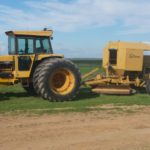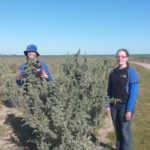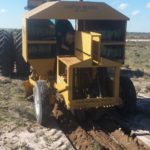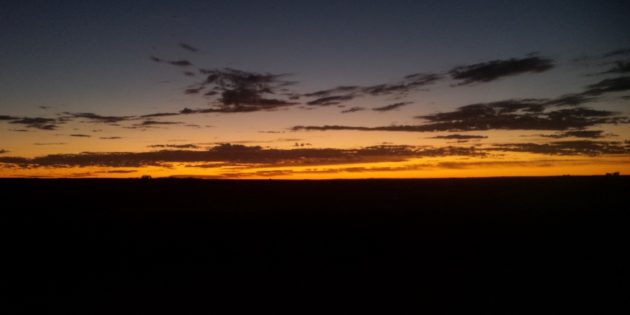When we bought our venue in 2010, we were faced with a lot of issues to deal with. The 100 or so year old farm had been victim to much human activity, not all of it good. Before we bought the farm we knew the property had salt issues and roughly one third was not suitable for traditional farming. This was no major concern for us in the beginning as we bought the farm for Motorsport. We did however want to green the farm and as rally drivers we’d much rather have trees to race around than open ground. That started my research into ways to reduce or reverse salinity. Some time on Google led me to Saltland Genie where I found a great deal of good information. I also watched some YouTube videos that featured WA Wheatbelt farmers and hatched a plan. In the winter of 2011 we planted our first 4000 saltbush. Our neighbour helped us out a lot. He was also interested to see how well it would work.
What is dry land Salinity?
Dry land salinity is a process that can take 50 years to show itself. Clearing the land bare and then planting crops is not ideal. No one knew any different back then and so millions of hectares of land were cleared. Without deep rooted trees to catch water and keep the water table down, the water rose closer to the surface and brought salt with it. At first crop yields started to drop then patches of crop would fail and eventually whole paddocks were useless. Worst affected areas were low lying in valleys and close to winter creeks and streams. Water logging was closely tied in and as wet soil dried in the warmer months, salt literally laid on the surface. It soon became salt scolded. Our farm, like much of the WA Wheatbelt has high clay content in the soil which doesn’t help either.
Tree Planter
We found the tree planting machine fairly easy to use. It doesn’t take much to operate and with two or three people you can plant quite quickly. We selected our first area, a patch that had some higher raised sections and some lower areas. The whole 4000 were planted in the same area. After using the tree planter, the area does not look like much. There are rows of ploughed soil and if you look closely you can see green tufts at regular intervals. It almost looks like any other seeded paddock. We constantly monitored our saltbush for that first 12 months. It was not a high rainfall year and at times during summer I thought we’d lose the whole lot. Instead of losing all our saltbush, they actually took well. I’d estimate the survival rate at 98%. I did notice that those planted in the better soil grew faster, however all became well established. Our neighbour too was impressed and has trialled a few thousand salt bushes on his own farm.
people you can plant quite quickly. We selected our first area, a patch that had some higher raised sections and some lower areas. The whole 4000 were planted in the same area. After using the tree planter, the area does not look like much. There are rows of ploughed soil and if you look closely you can see green tufts at regular intervals. It almost looks like any other seeded paddock. We constantly monitored our saltbush for that first 12 months. It was not a high rainfall year and at times during summer I thought we’d lose the whole lot. Instead of losing all our saltbush, they actually took well. I’d estimate the survival rate at 98%. I did notice that those planted in the better soil grew faster, however all became well established. Our neighbour too was impressed and has trialled a few thousand salt bushes on his own farm.
2012 onward
Fast forward to 2016 and those tiny seedlings from 2011 are now 1.5m+ tall and going strong. Below the  saltbush, grasses are growing where the soil was once bare and native birds tend to visit the patch too. All signs that at least in that small area, the environment is recovering. Every year since, we have planted a few thousand Saltbushes with high survival rates. We soon turned to planting around some of our motorsport tracks. We found the tree planter will follow gentle curves without problem, however tight spots and infill is best planted by hand. For some hand planting we used a ripper to open the soil first. It did seem to help the seedlings grow faster, however even without ripping the saltbush establishes OK in the right conditions.
saltbush, grasses are growing where the soil was once bare and native birds tend to visit the patch too. All signs that at least in that small area, the environment is recovering. Every year since, we have planted a few thousand Saltbushes with high survival rates. We soon turned to planting around some of our motorsport tracks. We found the tree planter will follow gentle curves without problem, however tight spots and infill is best planted by hand. For some hand planting we used a ripper to open the soil first. It did seem to help the seedlings grow faster, however even without ripping the saltbush establishes OK in the right conditions.
Not all survived
We did however lose a few hundred one year. We have a flat area which is highly salty and very wet during  winter. We aptly call it our Salt Flat. One year we ripped along a fence line on the flat and hand planted. In that area survival was less than 20%. I don’t know if it was because of not being planted correctly or the salt and flooding or a combination. We intend to go back in with the machine and have another go. The tree planter is a clever design that rips, ploughs and creates a mound all in one action. I suspect this helps a lot as seedlings planted by machine grow quicker than those that are hand planted. It may keep the seedlings at the right height and offer protection over hand planting.
winter. We aptly call it our Salt Flat. One year we ripped along a fence line on the flat and hand planted. In that area survival was less than 20%. I don’t know if it was because of not being planted correctly or the salt and flooding or a combination. We intend to go back in with the machine and have another go. The tree planter is a clever design that rips, ploughs and creates a mound all in one action. I suspect this helps a lot as seedlings planted by machine grow quicker than those that are hand planted. It may keep the seedlings at the right height and offer protection over hand planting.
Native trees
In the last couple of years we have started planting native trees as well as salt bush. Oil Mallees have been the tree of choice. The trees take longer to establish and grow slowly in comparison to bushes. They do however draw and store a lot of carbon out of the air. Another great thing about these trees is they can be cut down to ground level and they will happily regrow. Most of the carbon is stored in the deep roots too. We’ve been planting the Mallees in the better soil and the saltbush on the poorer parts. Recently I found out that these trees will also tolerate salt and some water logging. The new information changed the game plan slightly.
2016
 This year we planted a total of 6000 seedlings, of those, 2000 were trees. In the lead up to our mid July planting we’d already received 40+mm of rain for the month. It was great for the crops with all the extra moisture. It also meant that the soil was already saturated. We saw our neighbour the night before we were to begin planting. He warned that if we got the tractor bogged, he’d probably get bogged trying to come in and pull us out. I’d have to buy a lot of cartons and then help him get his spraying done. The trouble was that almost everywhere we intended to plant, was in a lower area that could have been very wet. Sure enough the ground was very slippery in places and turning around at the end of some rows proved tricky! We had to go slowly to allow the planter to do its job properly. On each return pass we looked over into the row we’d just done and they were filling with water!
This year we planted a total of 6000 seedlings, of those, 2000 were trees. In the lead up to our mid July planting we’d already received 40+mm of rain for the month. It was great for the crops with all the extra moisture. It also meant that the soil was already saturated. We saw our neighbour the night before we were to begin planting. He warned that if we got the tractor bogged, he’d probably get bogged trying to come in and pull us out. I’d have to buy a lot of cartons and then help him get his spraying done. The trouble was that almost everywhere we intended to plant, was in a lower area that could have been very wet. Sure enough the ground was very slippery in places and turning around at the end of some rows proved tricky! We had to go slowly to allow the planter to do its job properly. On each return pass we looked over into the row we’d just done and they were filling with water!
More Rain!
Overnight another 14mm of rain fell. We still had the 2000 Oil Mallees to get in the ground on the Sunday. How would the ground be? Was I buying cartons? By dawn the rain had stopped and a cool clear day developed. As we passed by Saturday’s rows, we could see most had plenty of water in them. Our main access tracks had large puddles too. Before we got going we walked our planned areas and set boundaries. I didn’t want to plant into very salty soil or get the tractor stuck. We experimented with the trees and planted in both good and poorer soil. Some places it was wet, other places it was relatively dry. Time will tell how well the trees survive. If it all works out, the trees should be catching plenty of runoff water and also lowering the water table.
Where does Motorsport fit in?
It’s more a case of where do the trees fit in? We set or plan our motorsport tracks and rally stages before we start planting. That way we don’t have to clear trees later to make roads. Every tree or bush that has been planted at our venue has been funded by us. In other words, we’ve not been provided any trees or funding from any government grant or department. This has solely been our own initiative. Anyone that does a rally experience, enters a motorsport event, or an online course with us is contributing to our greening project. To date, we’ve planted more than 24,000 seedlings with plenty more to go! Who said Motorsport isn’t good for the environment?
Karl Drummond


Leave A Response